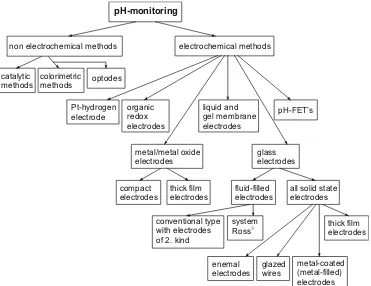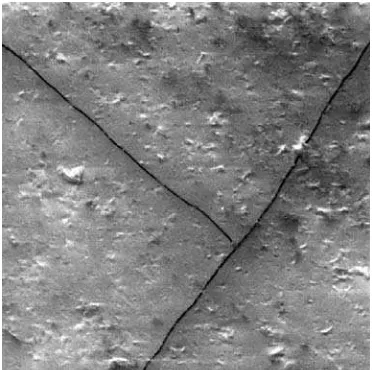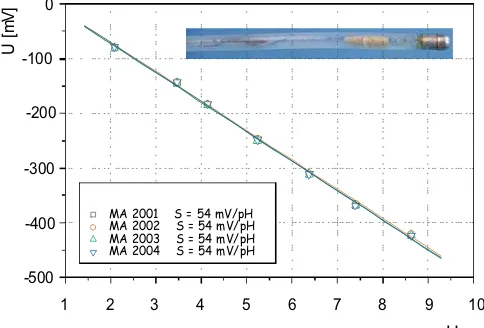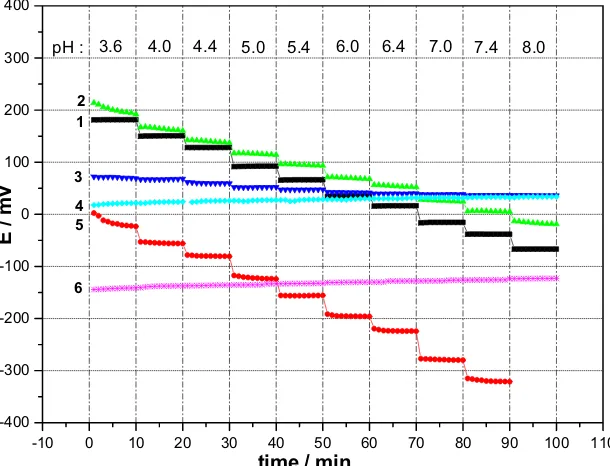– DOI 10.1007/s10008-006-0120-4
O R I G I N A L PA P E R
W. Vonau . U. Guth
pH Monitoring: a review
Received: 30 August 2005 / Accepted: 9 November 2005 / Published online: 26 April 2006
#Springer-Verlag 2006
Abstract Glass pH electrodes are being utilized for the measurement of pH values using liquid internal reference systems, which had been introduced on principle nearly hundred years ago and are still existing. To avoid several drawbacks in the practical usage of these kinds of chemical sensors, every effort has been made to develop an all-solid-state electrode with properties that are comparable to those of the conventional glass electrode. Metal oxide electrodes like RuO2 or IrOx are a low-priced alternative. Different concepts for substituting the conventional (aqueous) reference system by solid systems and also for changing the classical bulb shape design to a planar structured one have been proposed. A suitable reference system can be achieved by means of modification of classic reference electrodes by employing a new type of mixed conducting oxides. Both metal oxide and glass electrodes can be screen-printed on substrate materials like ceramics and plastics etc. to get miniaturized all-solid-state electrodes. pH sensors based on field effect transistors (FET) become more important. However, up to now an equivalent FET compatible reference electrode is not available.
Keywords Glass electrode . Metal oxide electrode . All-solid-state electrode . Thick film technology . Transition metal oxide bronze . CHEMFET . Reference electrode
Introduction
The determination of pH values is one of the most important tasks in analytical chemistry. From the beginning up to now, different electrochemical and nonelectrochem-ical methods are used in measuring pH values. In 1889,
Arrhenius [1] proposed a method using catalytic measure-ments. Widely applied colorimetry [2], which is based on the change of color of an organic acid–base system, is utilized nowadays in the so-called optodes for several niche applications of pH measuring technique [3].
At the present time, pH values are mostly determined electrochemically by using electrochemical reactions involving H+ or OH− ions, e.g., the hydrogen electrode
[4], electrodes based on redox systems (e.g., quinhydrone) [5], several metal/metal oxide electrodes [6], polymer matrix electrodes [7], glass electrodes [8], and CHEMFET sensors [9]. The function of these electrodes is based on the Nernst equation.
Among the different types of pH measuring electrodes, the glass pH electrode has occupied a unique place because of its excellent electrode performances with respect to slope, long-term stability, selectivity, detection limit, and insensitivity vs redox systems. As is generally known, this electrode contains buffer solutions and additional special anions in definite concentrations. The species of those anions depend on the species of the electrode system of the second kind, which serves as an internal reference system for the glass electrode. Often, chloride ions in a concen-tration range between 1 mol l−1and the saturation state are chosen.
While in the past glass electrodes have been used only at temperatures between 10 °C and to a maximum of 60 °C, an extensive development work has been done to enhance the working temperature range of the electrodes from−25
to 130 °C. However, there are no such glass electrodes, which cover the entire range of temperature.
The traditional glass electrode with an internal liquid reference system, as all other electrodes, exhibits some drawbacks [10]. For instance, the position dependence when the electrodes are stored or used is inconvenient. Furthermore, the pressure and temperature dependence, the mechanical fragility, and several limitations concerning the miniaturization are unfavorable. That is the reason why, for a long time, the main goal is to develop an all-solid-state electrode for pH measurement. Antimony and bismuth electrodes are to be considered as solid-state sensor
W. Vonau (*) .U. Guth
Kurt-Schwabe-Institut für Mess- und Sensortechnik e.V. Meinsberg,
Kurt-Schwabe-Straβe 4,
04720 Ziegra-Knobelsdorf, Germany e-mail: info@ksi-meinsberg.de Tel.: +49-343276080
materials, but their pH measuring range is limited, and they are also sensitive to several redox agents [11].
In this paper, different concepts for making pH electrodes without using liquid component systems are described and discussed comparatively. According to Fig. 1 the sensors based on those concepts were incorporated into the spectrum of all possible pH-measuring methods. The reference electrode, which is necessary for all potentiometric electrochemical cells, is not discussed in more detail. Some results regarding the improvement of a practically applicable electrode are summarized elsewhere [12].
All-solid-state pH glass electrodes
The main problem, which has to be solved to develop a solid-state glass electrode, is to connect the ionic conduct-ing glass with an electronic conductor. In the sense of electrochemistry, this contact is an electrode. Although the current is very low due to the high resistance of the glass, a reversible electrochemical reaction takes place on the phase boundary by transferring sodium or lithium ions into the electrode.
The possibility to fabricate all-solid-state glass elec-trodes is already mentioned in principle by Kratz [13]. According to the electrochemical requirements, it is not sufficient to use metals instead of buffer solutions as internal reference electrodes. So it was tried unsuccessfully
to coat bright platinum wires with electrode glass [14]. In this system, the electrochemical reaction was blocked. Improved approaches were to arrange a silver plate on the inside of glass membranes [15,16], to fill glass electrode bodies with mercury or several amalgams [17], or to solidify melts of alloys with low melting points within glass electrode bodies [18]. Due to the solution of sodium or lithium and cadmium in the mercury or in the metal, the electrode reactions can become reversible.
Several authors have tried to use materials having both electronic and ionic conductivity as an internal reference system [19]. In [20], the contact between noble metals with selective glasses by an interlayer of glass with mixed conductivity was described. Tungsten bronze as a mixed conducting material was connected with the inner glass membrane surface by means of modified carbon fleece [21]. This basic idea, developed further by Vonau et al. [22] (see Fig. 2), was realized in a normal-shaped glass electrode, which consists of a sandwich of pH-sensitive glass and mixed conducting glass, which have been manufactured free of cracks. Together with the inner surface of the electrode shaft, the inside of the membrane was metallized using a chemical reductive procedure. It is important that all treated glasses coincide widely in their expansion coefficient (Δα<6.10−7K−1).
It has been shown (see the following scheme), that the measuring behavior of such electrodes, due to better reversibility, is much better than that of electrodes with directly metallized pH glass membranes [23] (see Fig.3).
catalytic methods
colorimetric
methods optodes
non electrochemical methods
pH-monitoring
electrochemical methods
Pt-hydrogen electrode
organic redox electrodes
liquid and gel membrane electrodes
pH-FET’s
metal/metal oxide electrodes
compact electrodes
thick film electrodes
glass electrodes
fluid-filled electrodes
all solid state electrodes
conventional type with electrodes of 2. kind
system Ross
enemal electrodes
glazed wires
metal-coated (metal-filled) electrodes
thick film electrodes Fig. 1 Experimental methods to
noble metal (e−)
/ sodium and iron containing glass with mixed conduction (Na+, e−)
/ ionic con-ducting glass (Na+)
/ Measuring solution (Na+)
I II III
e− electronic conduction e−, Na+
mixed electronic and ionic conduction
Na+ ionic conduction I, II,
III
phase interface
The electronic conductivity of the mixed conducting glass should preferably be caused by an oxide of a transition metal, e.g., Fe2O3. Electroless silvering has been proven satisfactory to metallize this glass [24].
Furthermore, cation selective enamel electrodes are known [25, 26]. Here, the outer enamel layer acts as a
selective membrane. For the purposes of measuring the internal potential, a part of the ground enamel is covered by a thin silver layer, which is also coated with ion selective enamel. Sometimes, enamel electrodes are not completed with conventional reference electrodes. Instead of that, an electrode consisting of a Na+-sensitive enamel layer, which covers a steel tube, is used [27]. This concept was also realized in thick film technology [28]. However, the application of such sensors is strongly limited because in real media, a constancy of the activity of sodium ions can hardly be assumed.
In [29], all-solid-state pH glass electrodes with“Prussian Blue” as internal reference electrodes have been investigated.
Fabrication of thick film and thick film/hybrid electrodes for the pH determinations was also described in the literature [30–33]. Oxide ceramics, often made of alumina, were used as substrate materials and as internal reference system noble metal pastes. Compared with conventional and with many other all-solid-state glass electrodes, all those thick film sensors show a significantly lower lifetime. Additionally, because of high impedance values, it is partly necessary to carry out the measurements in a Faraday cage. The electrode slope does not quite obey the Nernst equation. Response times unfortunately are in the range of minutes. Because of undefined phase interfaces, the problem of variation of measured values occurs. The most important disadvantage is the differenceΔαof the thermal expansion coefficients between substrate and glass, which amounts to 50×10−7 K−1 in the case of usage of Al
2O3 -ceramics and pH glass Corning 015 [34], and according to Fig.4, this mostly causes cracks.
In [35], a planar pH glass sensor in a thick film technology has been introduced, using a steel substrate (αsteel≈11×10−6 K−1), a glass system including sensitive and mixed conduction glass and a potential junction system consisting of an Au–Ag alloy.
Fig. 2 pH glass electrode with reversible internal phase boundaries
time [d]
U
[
m
V
]
0 20 40
300 350
Fig. 3 Electrode functions of different all-solid-state pH glass electrodes
For the preparation of glasses with coefficients of expansion in good agreement with that of the steel substrate, the following raw materials have been used:
1. pH glass68.61 wt% SiO2, 18.41 wt% Na2O, 6.44 wt% MgO, 6.54 wt% UO3
2. Mixed conducting glass 36.9 wt% SiO2, 16.1 wt% Na2O, 43.4 wt% Fe2O3, 3.6 wt% Al2O3
The electrode performance has been presented in detail in [36].
Provided that the encapsulation can be carried out in a good quality, electrode slopes S>52 mV pH−1 could be measured over a period of several weeks.
The electrodes could be stored at dry conditions. Their chain zero points (emf=0) were different to other metal contacts investigated between pH 6 and 7 [37].
Attempts have also been made to contact glass elec-trodes by using conducting polymers or polymer mixtures, minimizing the mechanical stress of the glass membrane. In particular, soot-filled elastomers have been used [38].
Because the soot contains oxygen to an extent of 0.5 to 15%, acidic or basic surface oxides [39] are formed. These groups, which are able to form an ion exchange, are the reason for well-operating sensors [40].
Over the past years, investigations have been made to use intrinsic conducting polymers, such as polyaniline or polypyrrole by [41,42]. Here, it was possible to fabricate electrodes of the dipping type, but it was not possible for soot-filled elastomers. The main problem was the poor adhesion of polypyrrole on the glass surface, which was solved by using a second polymer as glue material [43]. For this purpose, the proton conductor Nafion was chosen with its outstanding ionic conductivity stabilizing the charge exchange inside the solid-state contact. According to Fig.5, this application resulted in solid-state pH electrodes of good performance. A more detailed discussion of the mechanism of charge transfer across the interface mixed conducting polymer/ion-selective membrane was given elsewhere [44].
Schindler [45] described a procedure to get all-solid-state glass electrodes, in which the ion selective glass
membrane on its internal side was brought in contact with an electrolytically conducting layer, consisting of conduct-ing lutconduct-ings and cements.
The disadvantage of this concept is the displacement of these materials at small temperature changes. This was also the case with the above-mentioned electrodes with soot filling. Flow-through-electrodes of the same design, at which a tube of electrode glass has been fused with shaft glass tubes [46] to strengthen the contact between soot and pH glass, were better-suited.
Metal oxide electrodes
It is well-known that casting metals consisting of Sb or Bi covered by a thin hydroxide layer, which has been generated in contact with aqueous solution or wet air, show a relatively high selectivity for hydrogen ions [47]. The main disadvantage of such metal/oxide electrodes is a systematic deviation from the expected Nernstian behavior, so that its application is restricted. But especially for medical applications and in the field of food control, often 3
4 5 6 7 8 9
0 50 100 150 200 250 300
fluid-filled poly-pyrrole pH 7
pH 4
pH 7
tap-water
p
H
time [min] Fig. 5 Response behavior of a
polypyrrole-based all-solid-state pH glass sensor compared to that of a usual fluid-filled sensor at 25 °C
1 2 3 4 5 6 7 8 9 10
-500 -400 -300 -200 -100
0
MA 2001 S = 54 mV/pH MA 2002 S = 54 mV/pH MA 2003 S = 54 mV/pH MA 2004 S = 54 mV/pH
U
pH
[m
V
]
antimony electrodes are used. Sensors for the pH measurements in gastroenterology [48] and in brewing [49] are examples of recent developments. By means of a newly developed casting procedure, using centrifugal power (rpm >1,800 min−1
), metals with improved properties can be obtained. Metal/metal oxide electrodes produced in such a way show nearly theoretical potential slopes [50] (see Fig.6) in a temperature range between 25 and 40 °C.
Metal oxide electrodes based on thick film technology
pH sensitivity is also been observed with other metal oxides, such as ruthenium oxide. It could be shown that screen-printed oxides on ceramics, which were sintered under definite conditions, gave better sensor responds than oxides that were printed on polymer sheets. Well-known is the application of screen-printable RuO2 as membrane
material [51]. It could be shown that in this case, cermet technology is superior to polymer paste technology.
Recently, thick film pH electrodes based on RuO2have been used successfully in multisensor arrays in lab on chip systems, to detect metabolisms in living cells (see Fig.7) [52] and in sensor cards in the dimension of check cards [53]. Experiments using standardized cell lines (e.g., L 929) showed that the RuO2thick film pastes are biocom-patible. The described oxide electrodes work at tempera-tures up to 130 °C.
When electrodes based on zirconia are used, the measuring temperature can be extended up to 400 °C [54].
pH electrodes with membranes of transition metal oxide bronzes
Tungsten and molybdenum bronzes have been investigated as possible pH sensitive materials since the 1960s. Tungsten bronze electrodes could not to be used in direct pH determination, but should follow pH titration [55]. The response was−46 mV/pH for Li0.3MoO3and−76 mV/pH for Na0.9Mo6O17. Molybdenum compounds are stoichio-metric and more stable [56]. The electrochemical reactions can be described by the following equations:
NaxWO3þyHþþye $NaxHyWO3
AxMoyOzþδHþ
þδe
$AxHδMoyOz
AxMoyOzþδHþ
$AxδHδMoyOzþδA
þ
The exact mechanism of the pH detection is not known yet.
Fig. 7 Lab on the chip system including a pH electrode in thick film technology based on screen-printed RuO2
-10 0 10 20 30 40 50 60 70 80 90 100 110
-400 -300 -200 -100 0 100 200 300 400
6 5 3
4 2 1
8.0 7.4 7.0 6.4 6.0 5.4 5.0 4.4 4.0 3.6 pH :
E /
mV
time / min
Chemical sensitive field effect transistors
Chemical sensitive field effect transistors (CHEMFETs) are comparable with MOSFETs (metal oxide field effect transistors). On CHEMFETs, the gate is coated by an ion-selective membrane. In case of determination of H3O+ -activity based on CHEMFETs, the terms pH-FETs or (more common) ISFETs have been introduced. Here, the ion-selective layer consists of SiO2, Si3N4, Ta2O5 or Al2O3. Ta2O5is preferred as a pH-sensitive layer. Furthermore, in this context, terms like K-ISFETs (potassium selective FETs), REFETs (pH-FET, which is in contact with a buffer gel) and GASFETs (gas sensitive FETs) are used [57].
Two problems have accompanied the development of CHEMFETs from the beginning [58]:
1. Incompatibilities with a direct contacting of ion-selective membranes
2. Technical difficulties concerning the encapsulation of the electronic components because of their sensitivity to wetness
Particularly for pH-FETs, the last problem was solved by development of advanced packaging technologies, and an economical mass production of CHEMFET sensors is now possible. The major problem is still to find a compatible reference electrode [59]. Also, the nonapplicability of hitherto existing pH analyzers (high-impedance mV meters) prevents the broad commercial acceptance of CHEMFET sensors up to now.
Anyhow, it was possible to introduce pH-FET-sensors successfully in some important applications, where other pH electrodes could not be used at all or with several disadvantages [60–62].
Reference electrodes
The technological progress, which has been accomplished with the introduction of pH-FET sensors and with other all-solid-state indicator electrodes described here, is limited by the absence of an adequate reference electrode. A separate conventional reference electrode is still necessary for the measurements. Hybrid sensors have been suggested, which can be miniaturized on a limited scale. Most of the hitherto known solutions are focused on a solidification of the reference electrolytes of traditional electrodes of second kind. Gels of polyvinyl alcohol, polyacrylamide [63], or mixtures of different gels [64] are known. On the other hand, screen-printing of suitable pastes [65] and a positioning of reference elements, as well as of reference electrolyte in synthetic resin [66] have been used, and fabrication of above-mentioned REFETs was tried [67].
One new concept (see Fig. 8) is to use transition metal oxide bronzes as materials for electrochemical reference electrodes. Electrodes having compositions like LixMo1−yWyO3 are promising, but still some problems concerning the workability of these substances exist [68].
References
1. Arrhenius S (1889) Z Phys Chem 4:226
2. Kolthoff IM (1932) Säure-Basen-Indikatoren. Springer, Berlin Heidelberg New York
3. Peterson JI, Goldstein SR, Fitzgerald RV (1980) Anal Chem 52:864
4. Krodatzki W (1933) Taschenbuch der praktischen pH-Messung. Müller & Steinicke, München, p 58
5. Biilmann E (1921) Ann Chim 15:109
6. Schwabe K (1976) pH-Messtechnik. Theodor Steinkopff, Dresden, pp 102–119
7. Galster H (1990) pH-Messung. VCH, Weinheim, pp 159–161 8. Eisenmann G (1967) Glass electrodes for hydrogen and other
cations. Marcel Dekker, New York
9. Bergveld P (1972) IEEE Trans Biomed Eng 19:340
10. Oehme F (1991) Ionenselektive Elektroden. Hüthig, Heidel-berg, p 1
11. Schwabe K (1974) Physikalische chemie, Bd. 2 (Elektrochemie). Akademie-Verlag, Berlin, pp 199–200
12. Kaden H, Vonau W (1998) J Prakt Chem 340:710
13. Kratz L (1950) Die Glaselektrode und ihre Anwendungen. Dietrich Steinkopff, Frankfurt, pp 58–62
14. Wolf K (1927) Collegium 688:370 15. Haugaard G (1932) Z Phys Chem 160:393 16. Lousier J (1942) Ann Inst Pasteur 68:373 17. v Lengyel B (1931) Z Phys Chem 153:3315
18. Voigtländer G (1963) Versuche zur Herstellung stabiler Glaselektroden. Diploma Thesis, Technische Hoch-schule Dresden
19. Deportes C, Forestier M, Kahil H (1986) Conference “Capteurs”, Paris, p 86
20. Sul’z MM, Pisarewskii AM, Wolkow CE, Lepnew GP, Artmew JM, Nikolajew JM (1981) Phys Chim 7:426
21. Inorm-Electro (1986) pH electrodes with internal solid contact for medical use. Prospectus, Moscow
22. Vonau W, Gäbler D, Kaden H (1997) Glaselektrode mit innerem Festkontakt und Verfahren zu ihrer Her-stellung. German patent DE 19620568
23. Vonau W, Kaden H (1997) Glastech Ber Glass Sci Technol 70 (5):155
24. Vonau W, Gabel J, Jahn H (2005) Electrochim Acta 50:4981 25. Schwab A, Ehret R (1977) Meβsonde zum Bestimmen der
Ionenkonzentration in Flüssigkeiten. German patent DE 2133419
26. Emmerich B (1978) Reglungstechn. Praxis 20:313
27. Anonym (1997) Pfaudler and Yokogawa industrial automation. Prospectus, Newman, Georgia
28. Vonau W, Enseleit U, Otschik P, Kretzschmar C, Hennig C, Groβe M, Woithe W (2000) Einstabmesskette. German patent DE 100 22 210
29. Noll A, Rudolf V, Grabner EW (1998) Electrochim Acta 44 (2):415
30. Belford RE, Owen AW, Kelly RG (1987) Sens Actuators 11:387
31. Tedjar F, Zerroual L (1990) Sens Actuators B2:215
32. Läppävouri SI, Romppainnen PS (1983) The use of hybrid microelectronics in the construction of ion-selective electrodes. Electrocomp Sci Technol 10:129
33. Liu JH, Zhang YH, Ni L, Li XH (1993) Zeitschrift angeben 566 34. Mac Innes DA, Dole M (1929) Ind Eng Chem 1:57
35. Vonau W, Kaden H, Kretzschmar C, Otschik P, Krabbes I, Woithe W, Groβe M (1997) Elektrochemischer Sensor und Verfahren zu seiner Herstellung. German patent DE 1976 14474
37. Vonau W, Kaden H, Kretzschmar C, Otschik P (1998) Metallkontaktierte Glaselektrode in DS-Technik. In: Baselt JP, Gerlach G, Göpel W (eds) Dresdner Beiträge zur Sensorik. vol. 5 Chemie- und Biosensoren. Aktuelle Anwendungen und Entwicklungstrends. Dresden Univ. Press, Dresden-München, pp 7–10
38. Kaden H, Vonau W (1990) Messen-Steuern-Regeln 33(7):312 39. Ullmann (1977) Enzyklopädie der Technischen Chemie. VCH
Verlagsgesellschaft, Weinheim, Bd 14, p 635
40. Vonau W (1989) Thesis. Bergakademie Freiberg, Freiberg/Sa 41. Jahn H, Berthold M, Kaden H (2002) Festkontaktierte
pH-Glaselektroden unter Einsatz eines intrinsisch leitenden Poly-mers eines intrinsisch leitenden PolyPoly-mers. In: Baselt JP, Gerlach G (eds) Dresdner Beiträge zur Sen- sorik, vol. 16. w. e.b. Universitätsverlag, Dresden, pp 174–177
42. Jahn H, Kaden H, Berthold M (2004) Macromol Symp 210:385 43. Jahn H, Kaden H (2004) Microchim Acta 146:173
44. Bobacka J (1999) Anal Chem 71:4932
45. Schindler J (1980) Verfahren zur Herstellung eines elektro-chemischen Meβfühlers. German patent DE 3010470 46. Kaden H, Vonau W, Jentzsch J, Semm K (1990) Glaselektrode
für elektrochemische Messungen. German patent DD 284 533 47. Hamann CH, Vielstich W (1981) Elektrochemie II. VCH,
Weinheim, p 301
48. Vonau W, Mitschke F, Teichmann P, Schönfeld A (2001) Medizinische Sonde. German trade Mark Az. 201 06 162.7 49. Vonau W, Oelβner, W, Henze J (2002) Elektrochemische
Kombinationselektrode. German trade Mark Az 202 12 126.7 50. Vonau W, Kaden H (2002) Elektrochemische Chemo- und Biosensoren - Einsatz in der Medizintechnik, in der Lebens-mitteltechnologie und für andere Anwendungen. In: Kaden H (eds): Biosystemtechnik. Beiträge des Innovationsforums 2001, Waldheim, pp 143–150
51. Vonau W, Decker M, Strienitz T, Gläser, M, Kaden, H (2000) GIT Labor-Fachzeitschrift 44:127
52. Herrmann S, Vonau W (2004) TM Tech Mess 71:613 53. Vonau W, Enseleit U, Gerlach F, Herrmann S (2004)
Electrochim Acta 49:3745
54. Ding K, Seyfried WE (1996) Science 272(5268):1634 55. Gabel J, Vonau W, Guth U, DE 102 52481
56. Shuk P et al (1996) Electrochim Acta 41:2055–2058
57. Oehme F (1991) Ionenselektive Elektroden. Hüthig, Heidel-berg, p 39
58. Gründler P (2004) Chemische Sensoren. Springer, Berlin, Heidelberg, New York, pp 165–168
59. Oelβner W, Zosel J, Guth U, Pechstein T, Babel W, Connery JG, Demuth C, Grote Gansey M, Verburg JB (2005) Sens Actuators B105:104
60. Oelβner W, Kaden H (1991) Werkst Korros 42:356
61. Bellée H, Kaden H, Oelβner W (1993) Z Geburtshilfe Perinatol 197:148
62. Lehmann M, Baumann W, Brischwein M, Gahle HJ, Freund I, Ehret R, Drechsler S, Palzer H, Kleintges M, Sieben U, Wolf B (2001) Biosens Bioelectron 16:195
63. Yano M, Nakamura M, Maruyama H, Kajltani K (1982) Steam autoclavable reference electrode. European patent EP 0095376 64. Vonau W, Gabel J, Teichmann P, Lange R (2000) Bezugselek-trolyt und Verfahren zu dessen Herstellung German patent DE 100478255
65. Gerlach F, Vonau W, Kaden H (2002) Scientific Reports, J Univ of Appl Sci Mittweida 10:123
66. Russel TH, Haaf D (1987) Referenzelektrode für die Ionenak-tivitätsmessung,insbesondere für die pH-Wert- messung. Eu-ropean patent EP 0247535
67. Comte PA, Janata J (1978) Anal Chim Acta 101:247



